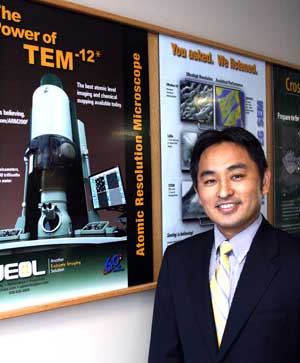 With just the right touch for fine tuning the optics of ultrahigh resolution microscopes, JEOL Applications Specialist Dr. Toshi Aoki is helping customers optimize the powerful imaging and analysis capabilities of their JEOL field emission TEMs. Starting in September, he will also serve as Visiting Scientist at Lehigh University, with opportunities to co-publish on new discoveries while putting the 200 keV FE TEM with Cs STEM corrector through its paces.
With just the right touch for fine tuning the optics of ultrahigh resolution microscopes, JEOL Applications Specialist Dr. Toshi Aoki is helping customers optimize the powerful imaging and analysis capabilities of their JEOL field emission TEMs. Starting in September, he will also serve as Visiting Scientist at Lehigh University, with opportunities to co-publish on new discoveries while putting the 200 keV FE TEM with Cs STEM corrector through its paces.
High resolution microscopy has fascinated Aoki since he began his education in materials science at Kumamoto University in Japan. For his Ph.D. and post-doctorate work, he selected Arizona State University for its well-known microscopy program. Still eager for more rounded understanding of the instruments themselves, he joined JEOL USA’s TEM Service Department in 2004 and has since become an expert in Field Emission TEM from the hardware perspective as well as the applications perspective.
Since that time, Aoki has helped many customers with optimizing the performance of their Field Emission TEMs for their specific applications. While assisting with training at the Lehigh School of Microscopy, he made improvements to the JEM-2200FS that is in demand for research not only at the Bethlehem, Pennsylvania campus, but also through remote operation by outside research labs. Now as Visiting Scientist on a monthly basis, he will be working with Christopher Kiely, Professor and Director of the Nanocharacterization Laboratory and Lehigh School of Microscopy, and Masashi Watanabe, Associate Professor of Materials Science and Engineering.
Aoki will continue to support FE TEM customers and share his knowledge as well as continuing his efforts in training JEOL service engineers in advanced techniques, for which he has demonstrated an excellent talent.
When Aoki joined JEOL USA, Pat McGinley, VP and GM of Service, was filling a need after the widely successful introduction of the first JEOL Field Emission Transmission Electron Microscope in the United States. The field emission TEM required different skills for the high resolution optics and analytical capabilities of the advanced instrumentation and a growing base of customers called looking for a new level of support. Someone of Aoki’s experience was a natural match for JEOL.
“Toshi had a great knowledge of scientific applications, which would have been, by itself, beneficial to JEOL, but he also wanted to learn the fundamentals of the instrument – he was interested in the hardware and how to test it,” McGinley explains. Aoki began to learn the instrument from the ground up by working onsite with JEOL installation teams. His first installation took him to Ecole Polytechnique in Canada during one of the coldest times of the year. He has since supported multiple installations and acceptance tests, and has written a manual for acceptance test procedures that can easily be followed by TEM engineers in the field.
“The first part of my career at JEOL was to understand the instrument and how to get the best performance out of it, then pass that knowledge on to the engineers,” Aoki says. When I visited Lehigh to assist with the Microscopy School, I found that my experience enabled me to improve the performance of the STEM corrector. At this point Lehigh asked that I consider a Visiting Scientist position to investigate improvements to the instrument.” These improvement techniques can be applied to the Lehigh instrument to optimize it for high resolution imaging and EELS and EDS. His work will not only benefit both JEOL and Lehigh but other customers wishing to get the most out of their JEOL FE TEM.
Bridging the gap between theoretical knowledge and the engineering side of the instrument, Aoki’s experience combines two professions. His own research on semiconductor heterostructures and nanostructures delved into Groups II-VI (infrared), III-V (gallium), and IV materials, as well as carbon nanotubes, nano-particles, catalysts, quantum dots, quantum well, and nanowires.
He feels privileged to have worked with the many outstanding microscopists at ASU’s John M. Cowley Center for High Resolution Microscopy, including Professor Ray Carpenter, a committee member for Aoki’s Ph.D. thesis, and Professor David J. Smith, his thesis advisor, who is also President of the Microscopy Society of America. He credits his mentor, Professor Minoru Nishida of Kyushu University in Japan, for showing him what a TEM could do. “To be able to acquire fine details, structural, crystallographic, chemical, and electronic information of materials in a very small area – I thought that was fantastic that with one instrument you can do all that.”
With the introduction of the new JEOL Schottky/cold field emission TEM with integral Cs Corrector, the ARM200F, Aoki will also travel to JEOL Japan to spend time learning the capabilities of a TEM with ultrahigh resolution of 80 picometers. He has achieved his own dream early in his career, working with the most powerful microscopes in the world, and will continue to raise the level of JEOL’s service engineering staff’s understanding of the fine tuning of these high performance instruments.
https://www.jeolusa.com/NEWS-EVENTS/Press-Releases/PostId/7/JEOL-TEM-Specialist-to-Serve-as-Visiting-Scientist-at-Lehigh-University





